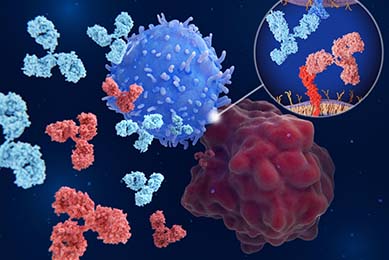
새로운 면역 치료제 “Immune checkpoint inhibitor”는 체내 면역 반응을 억제하는 암세포의 능력을 약화시켜 효과적인 차세대 항암 치료제로 주목 받고 있습니다1 . ATCC 3인의 전문가들이 말하는 Immune checkpoint inhibitor 연구의 중요성, 어려운 점 유용한 실험 모델에 대한 내용을 확인해 보세요.

Hyeyoun Chang, PhD Scientist, ATCC

Brian Shapiro, PhD Marketing Segment Manager, Oncology, ATCC

Hai-y Le, MA Digital Content Specialist
왜 중요한가요 ?
These novel therapeutics work by blocking the binding of immune checkpoint molecules on the immune cells to their ligands on the cancer cells. When this binding is blocked by immune checkpoint inhibitor molecules, the immune system is activated to kill the cancer cell.
연구에 어떤 어려운 점이 있나요 ?
While this type of therapy is promising, developing new checkpoint inhibitor therapeutics can be challenging due to the lack of physiologically relevant models.
For instance, some of the current models used for the clinical development of these inhibitors are syngeneic mouse models and humanized mouse models.2 While these models provide valuable information in understanding immunological mechanisms and testing potential cancer immunotherapy drugs, they suffer from the inherent differences between the mouse immune system or human/mouse hybrid immune system and the human immune system.3
In vitro drug screens that use fully human ex vivo immuno-oncology assay models overcome the inter-species immune disparity. For example, co-culture assays of human T cells and human cancer cells can be used to observe the direct cytotoxic effects of T cells on cancer cells and evaluate inhibitor efficacy.4 The use of primary immune cells and patient-derived cells adds physiological relevance to the assay; however, these cells pose unique challenges such as natural donor variability issues and the experimental outcomes are often difficult to reproduce.5
Another alternative is the use of an artificial system comprising cancer cells engineered to overexpress immune checkpoint molecules that are co-cultured with non-cytotoxic T cells harboring a T cell activation signaling reporter gene. While this option solves the reproducibility problem, it loses physiological relevance due to the forced expression of the checkpoint molecules.6
해결 방안이 있을까요 ?
To bridge the gap in checkpoint inhibitor therapeutic development, immuno-oncologists need access to physiologically relevant ex vivo reporter assay systems that incorporate cell lines that endogenously express high levels of immune checkpoint molecules. This type of reporter system would be more predictive of the in vivo situation while simultaneously allowing for the sensitive and qualitative assessment of signal transduction.
IO 연구에 도움이 되는 ATCC 제품은 어떤 것들이 있나요 ?
At ATCC, we set out to help immuno-oncologists test their novel checkpoint inhibitor drug candidates by providing them tools to create a robust reporter assay system. Our scientists conducted comprehensive protein profiling of our portfolio of human cancer and immune cell lines for immune checkpoint molecules. Based on this proteomic data, we developed “ immune checkpoint reporter cancer cell lines ” that endogenously express high levels of immune checkpoint molecules.
The cancer reporter cells contain a gamma interferon activation site (GAS)-response element upstream of the luciferase gene. Additionally, we used single cell cloning to select cells exhibiting robust and stable expression. In a luciferase-based assay, these cells produce a bioluminescent signal in response to immune activation due to the presence of an immune checkpoint inhibitor.
The bioluminescence signal can be readily detected and quantified to evaluate the efficacy, potency, and pharmacodynamics of the inhibitor in a screening assay. These immune checkpoint reporter cancer cell lines yield exceptional in vitro and ex vivo assay sensitivity and reproducibility. Furthermore, the high endogenous expression of immune checkpoint molecules in these cell lines delivers physiological relevance to the checkpoint assay.
Immuno-oncology Checkpoint Luciferase Reporter Cells (Cat#를 클릭하면 제품 페이지로 이동합니다)
| Designation | ATCC No. | Disease | Biomarker | Availability |
| HCC827-GAS-Luc2 | CRL-2868-GAS-LUC2 | Adenocarcinoma | PD-L1 | Available now |
| MG-63-GAS-Luc2 | CRL-1427-GAS-LUC2 | Osteosarcoma | CD-155 | Available now |
| NCI-H1650-GAS-Luc2 | CRL-5883-GAS-LUC2 | Adenocarcinoma | B7-H3 | Available now |
| SUP-T1 [VB]-NFAT-Luc2 | CRL-1942-NFAT-LUC2 | Lymphoblastic lymphoma | PD-1 | Coming soon |
References
- Korman AJ, et al. The foundations of immune checkpoint blockade and the ipilimumab approval decennial. Nat Rev Drug Discov 21: 509-528, 2022. PubMed: 34937915
- Kubli SP, et al. Beyond immune checkpoint blockade: emerging immunological strategies. Nat Rev Drug Discov 20: 899-919, 2021. PubMed: 33686237
- Olson B, et al. Mouse models for cancer immunotherapy research. Cancer Discov 8: 1358-1365, 2018. PubMed: 30309862
- Dijkstra KK, et al. Generation of Tumor-Reactive T Cells by Co-culture of Peripheral Blood Lymphocytes and Tumor Organoids. Cell 174: 1586-1598 e1512, 2018 PubMed: 30100188
- Versteven M, et al. A versatile T cell-based assay to assess therapeutic antigen-specific PD-1-targeted approaches. Oncotarget 9: 27797-27808, 2018. PubMed: 29963238
- Ribas A, Wolchok JD. Cancer immunotherapy using checkpoint blockade. Science (359): 1350-1355, 2018. PubMed: 29567705

APPLICATION NOTE
A PD-L1 Cell Line With GAS-Luc2 Reporter for Checkpoint Inhibitor Screening
* 주문 및 견적 문의는 지사/대리점으로 연락 주세요

